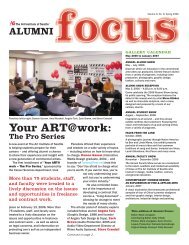2009 - 2010 Catalog - The Art Institutes
2009 - 2010 Catalog - The Art Institutes
2009 - 2010 Catalog - The Art Institutes
You also want an ePaper? Increase the reach of your titles
YUMPU automatically turns print PDFs into web optimized ePapers that Google loves.
UNDERSTANDING INTERIOR DESIGN<br />
Interior designers must have a thorough understanding of<br />
efficient space planning, human factors, color, pattern, lighting,<br />
furniture, and materials. <strong>The</strong>se elements are essential to<br />
the creation of residential and commercial spaces. Whether<br />
working for architectural or interior design firms, hotel or<br />
restaurant chains, department or furniture stores, or independently<br />
as consultants or firm owners, accomplished designers<br />
are adept at working with clients and understanding their<br />
needs.<br />
WHAT WILL I LEARN?<br />
Begin with a great foundation in basic rendering and perspective.<br />
Build your aesthetic and technical problem-solving<br />
skills, and discover the difference between designing for<br />
architectural firms, retail stores, hotels and restaurants. You’ll<br />
learn how to keep accurate records and discover how to<br />
buy wholesale. Students enter a world where color, texture,<br />
fabric, and light are instruments that paint an environment.<br />
Students are introduced to computer-aided drafting (CAD)<br />
and sample the real world of interior design in the studio, the<br />
showroom, and the business planning office.<br />
PROGRAM MISSION<br />
<strong>The</strong> mission of the Interior Design programs is to provide<br />
students with relevant skills preparing them for their profession<br />
of choice. Students will be able to conceive and execute<br />
viable and creative design solutions for diverse clients.<br />
30<br />
INTERIOR<br />
DESIGN<br />
Bachelor of Science<br />
12 Quarters<br />
PROGRAM OBJECTIVES<br />
Communicate and document design solutions through verbal,<br />
visual and written means.<br />
Demonstrate the ability to articulate design through manual<br />
and computer drawings and presentations.<br />
Appropriately apply building codes and accessibility guidelines.<br />
Utilize appropriate design processes to create comprehensive<br />
design solutions appropriate to client and employer<br />
needs.<br />
Demonstrate an ability to problem solve through the use of<br />
design elements, including specification of products and<br />
materials.<br />
Utilize research to achieve concept ideation and to execute<br />
appropriate design.<br />
Synthesize learned knowledge of the histories of architecture,<br />
art, design, and furniture to apply to design solutions.<br />
Apply professional standards and ethics in Interior Design<br />
business practices.<br />
GRADUATES ARE PREPARED<br />
By graduation, students have learned to control space and<br />
affect perceptions through the application of their art forms;<br />
the way color elicits response; the effect of ambient and task<br />
lighting on efficiency; and the ability of furniture design and<br />
placement to control mood and support function. We place<br />
great emphasis on the development of a professional portfolio<br />
for every Interior Design student. <strong>The</strong> Interior Design graduates<br />
are prepared to seek entry-level opportunities as residential<br />
planners, design consultants and project managers,<br />
among others. <strong>The</strong> length of the program is twelve (12), eleven<br />
(11) week quarters.
















